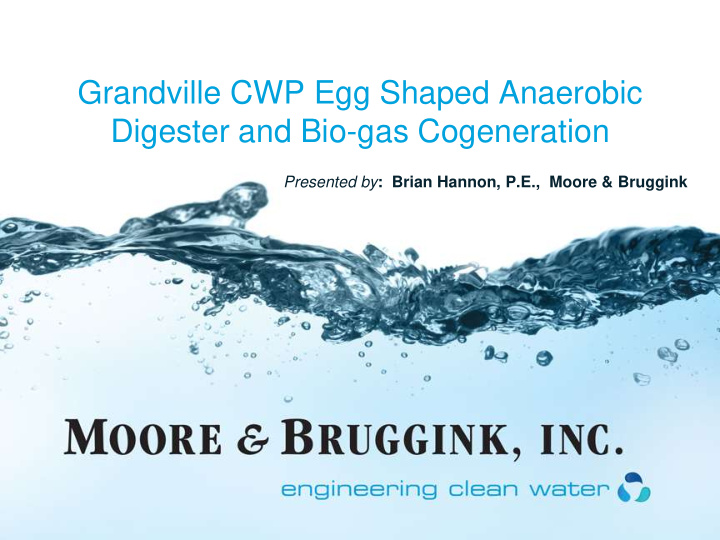



Grandville CWP Egg Shaped Anaerobic Digester and Bio-gas Cogeneration Presented by : Brian Hannon, P.E., Moore & Bruggink
Outline • Brief Project Background • Why ESD • ESD Startup • Cogeneration System • Energy Management • Current Performance vs. Design • Lessons Learned
City of Grandville Overview Grand Rapids US 196 131 Grandville
Customer Community Overview • Ottawa County • Georgetown • Hudsonville • Jamestown • Jenison • Blendon
Grandville Clean Water Plant
Grandville Clean Water Plant
Why Egg Shaped Anaerobic Digester (ESD)? • Process • Footprint • Cost (life cycle) – Cleaning – Efficiency • Client Comfort • Ability to go to Class A
ESD Pipe Gallery
Anaerobic Digestion • Relatively Simple • Known Technology • Produces two beneficial products w/ low energy input
How the ESD Works:
How the ESD Works:
How the ESD Works:
How the ESD Works:
Micro-Digestion Style Startup • Good Seed Sludge starts the process • Complete Control • Process Allowed to Acclimatize • No loss of Bio-Mass • Steady State Operation Quickly • Alkalinity Builds Quickly • Temperature Control
Complete Mixing = Better Digestion = More Biogas! (and no periodic cleaning!)
Grandville’s Biogas Components
Why Biogas Cleaning? • Biogas Impurities – Moisture – H2S – Siloxanes
Siloxane Damage to Boiler Silica Layer ½” to 1” Thick Pitting of Boiler Tubes
Siloxane Damaged Valve
Cogeneration System • Dual Fuel (bio-gas and natural gas) - 280 kW using Bio-gas, - 360 kW using Nat Gas • Internal exchangers to capture heat from engine cooling jacket and exhaust • Efficiency of 86%
Power
Heat
Integrated Energy Management System (IEMS) • ESD – Biogas Supply • ESD – Heat Demand • CHP – Biogas Demand • CHP – Heat Supply • CHP – Power Supply • System – Power Demand • Lab/Ops – Heat Demand
Biogas Production • Biogas Quantities – Currently producing ~120,000 cuft/day – Distribute between cogen, flare, and boiler
Power & Heat Production • 70,000 CF/day Biogas to CHP – Biogas Energy Content ~ 640 BTU/CF – Average Energy Demand ~ 175 kW • ~ $100,000 / year (@ $0.065/kWhr) – Electrical Efficiency 32%
Power & Heat Production • 70,000 CF/day Biogas to CHP – Biogas Energy Content ~ 640 BTU/CF – Average Heat Production: ~ 1.0 MMBTU/hr • Other than coldest periods of winter, heat production exceeds demand • Load Dump Radiator eliminates excess heat – Fuel to Heat Efficiency 54% – Overall Efficiency 86%
Power & Heat Production • (+) Producing sufficient heat to satisfy demand of ESD and Lab Ops during coldest periods • (-) Connected load is frequently not large enough to use all of the biogas being produced
Optimization • Optimization of ESD Gas Production – Balancing gas production with feeding times and quantities – Maintaining cleansing velocity in line – Look at potential co-feed feedstocks – Storage • Optimization of Power Production – Not using all the biogas – still flaring – Add loads
Costs and Payback • Elements of Capital Costs for Payback Analysis – Gas Cleaning Skid – Cogen Unit – Hot Water Pumps for Cogen – IEMS system – PEX lines to Lab/Ops Total “Additional” Capital = $850,000
Estimated Savings • Projected Energy Savings at Startup Rates – $95,000/yr • Projected Gas Savings at Startup Rates – $47,000/yr • Projected Payback – 6 years simple, 7.8 discounted
Actual Savings • Actual Energy Savings – Approx $98,000/year • Actual Gas Savings – Approx $22,000/year – Nat Gas is ½ price Utility bills have been lowered even with expanded plant! Approximately 25% of plant power is produced with CHP generator.
Where are we at today? • Consistently producing between 170-200 kW power. • Providing all heat necessary for digester and Lab/Ops. • Balancing sludge feed rates to optimize gas production. • Balancing heat draw from digester to better match production from cogen. • Reviewing feasibility of another transfer switch.
Going Forward • Dial in Feed Rates • Review and Optimize Load Usage vs. Energy Production – Consider additional transfer switch
Going Forward • Review Heat Usage vs. Production from Cogen – Consider removing tubes from ESD HX
Lessons Learned • Micro-digestion • Startup support • Power Connection to Turbo-blowers • Gas holder cover on old tank • 3-way Valve Plug Coating Material vs. Temp • Excessive Moisture in Bio-gas • Improved primary efficiencies
Questions? Brian Hannon, P.E. Todd Wibright Moore & Bruggink City of Grandville CWP (616) 363-9801 (616) 457-0720 bhannon@mbce.com wibrightt@cityofgrandville.com
Recommend
More recommend